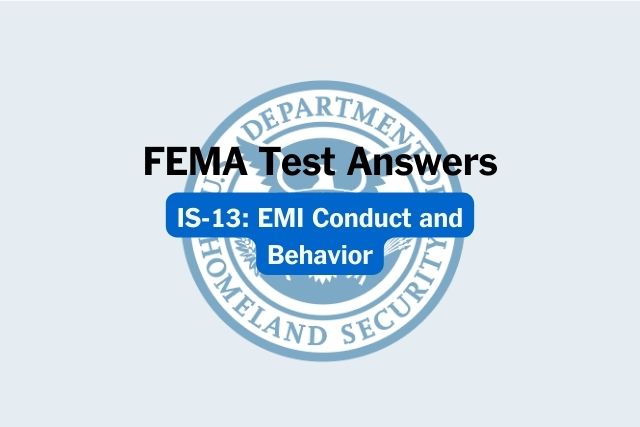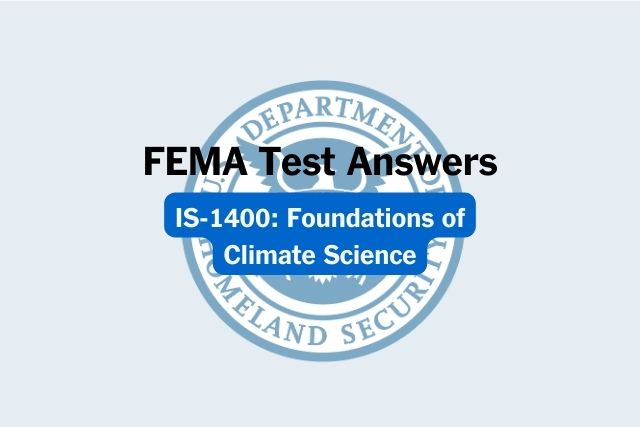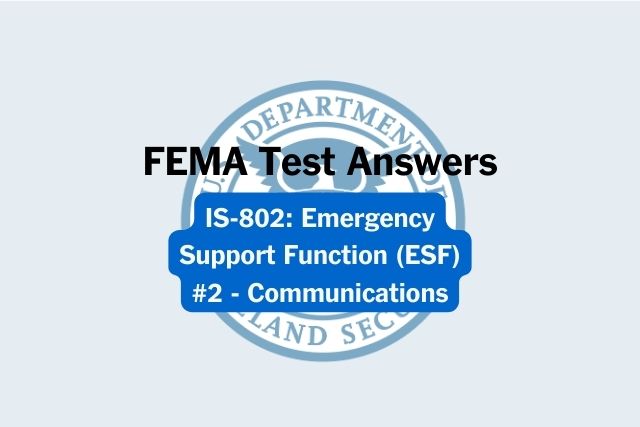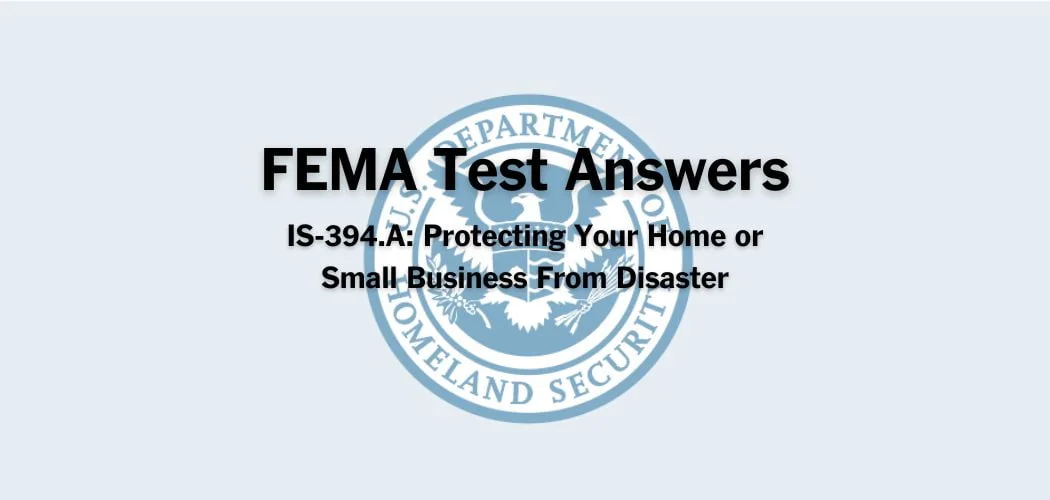Overview: The FEMA IS-1101.B course was published on 12/18/2017 to provide insurance agents an introduction to the National Flood Insurance Program (NFIP) and help them to gain an understanding of fundamental aspects of the program including general policy rules, regulations, flood map usage, proper rating methods and claims handling processes.
Upon successfully passing the IS-1101.B exam, you will receive a Certificate of Achievement noting CE earned through the International Association for Continuing Education & Training (IACET).
FEMA IS-1101.B test answers
Each time this test is loaded, you will receive a unique set of questions and answers. The test questions are scrambled to protect the integrity of the exam.
Question 1. When selecting the $10,000 residential deductible option, the same deductible must apply to both the building and its contents.
A. TRUE ✅
B. FALSE
Question 2. A policy was written with both building and content coverage. In the event of covered damage to both the building and contents, the policy will:
A. Apply only the contents deductible
B. Apply only the building deductible
C. Waive the deductibles
D. Apply separate building and contents deductibles✅
Question 3. A basement is defined as any area of the building, including any sunken room or sunken portion of a room, having its floor below ground level (subgrade) on all sides.
A. TRUE ✅
B. FALSE
Question 4. A portion of an elevated building below the lowest elevated floor that is either partially or fully shut in by rigid walls is called:
A. A basement
B. A breakaway wall
C. A proper opening
D. An enclosure✅
Question 5. What document is used as the basis to determine flood insurance premium rates?
A. Topography map
B. Standard Flood Insurance Policy coverage form
C. Elevation Certificate✅
D. All of the above
Question 6. Which areas of a community are identified as being at high risk of flooding?
A. D zones✅
B. V zones
C. X zones
D. All of the above
E. None of the above
Question 7. The HFIAA Surcharge is a flat fee applied to all buildings based on the flood zone.
A. TRUE
B. FALSE✅
Question 8. How close to grade does the bottom of the flood vent need to be located to be a proper opening?
A. 1 foot or less✅
B. 2 feet or less
C. 3 feet or less
D. 4 feet or less
Question 9. Where can current and historic FIRMs be found?
A. FEMA’s Flood Map Service Center ✅
B. The NFIP Flood Insurance Manual
C. The Community Status Book
D. The FloodSmart website
Question 10. In most cases, an Elevation Certificate is needed when rating a Post-FIRM building in a Special Flood Hazard Area (SFHA).
A. TRUE ✅
B. FALSE
Question 11. Post-FIRM refers to construction or substantial improvement that started on or before December 31, 1974 or before the effective date of the initial FIRM for the community, whichever is later.
A. TRUE
B. FALSE✅
Question 12. When FIRMs change, what grandfathering options do property owners have?
A. Use the rating structure of a policy that lapsed 5 years ago
B. Use the new FIRM to rate the building✅
C. Use the old Flood Hazard Boundary Map
D. Use the BFE in effect when the building was originally constructed
Question 13. The Residential Condominium Building Association Policy (RCBAP) has to be insured to at least ______ of the RCV, or to the maximum limits available, to avoid a coinsurance penalty.
A. 0.6
B. 0.7
C. 0.8 ✅
D. 1
Question 14. A Preferred Risk Policy _______.
A. is available to policyholders who have had insurance for at least 5 years
B. is a low-cost rating option
C. is available in low-and moderate-risk flood zones regardless of loss history✅
D. All of the above
E. None of the above
Question 15. Which one of the following water events best describes a “flood” as defined by the National Flood Insurance Program?
A. Water from a faulty home irrigation system that floods a homeowner’s backyard and basement
B. Rainwater that saturates the ground and leaks through basement walls
C. Water that escapes from a broken water pipe inside the building
D. Heavy rain that inundates the area and flows into several buildings✅
Question 16. What is the best source to find out if a community participates in the NFIP?
A. The Flood Insurance Study
B. The Elevation Certificate
C. The NFIP Flood Insurance Manual
D. The Community Status Book✅
Question 17. What information from an Elevation Certificate can assist in determining the Lowest Floor Elevation (LFE) for rating purposes?
A. Building diagram number
B. Number of proper openings
C. Location of machinery and equipment
D. Elevation of the top of the bottom floor✅
E. All of the above
Question 18. Which of these items is covered in a basement?
A. Refrigerator✅
B. Flat-screen television
C. Window air conditioning units
D. Carpeting
Question 19. The maximum coverage limit for a non-residential condominium building is:
A. $250,000 per unit
B. $500,000 per unit
C. $500,000 per building✅
D. $750,000 per building
Question 20. Increased Cost of Compliance’s maximum coverage limit is:
A. $15,000
B. $20,000
C. $25,000
D. $30,000✅
Question 21. A flood is a general and temporary condition of partial or complete inundation of two or more acres of normally dry land area or two or more properties (at least one of which is your property) from, for example:
A. Earthquake
B. Mudflow
C. Landslide
D. All of the above
E. None of the above✅
Question 22. The Preferred Risk Policy (PRP) offers coverage to owners and tenants of eligible buildings located in:
A. A99, AR, B, C, and X zones✅
B. Non-participating communities only
C. V and A zones only
D. Emergency Program communities only
Question 23. Flood insurance can be purchased in low- to moderate-risk flood zones in an NFIP participating community.
A. TRUE ✅
B. FALSE
Question 24. The Residential Condominium Building Association Policy (RCBAP) is used to write coverage for individual condo unit owners.
A. TRUE
B. FALSE✅
Question 25. Which of the following is a responsibility of an NFIP community?
A. Identify Coastal Barrier Resource System (CBRS) areas and Otherwise Protected Areas (OPAs)
B. Provide a listing of all insurance professionals who sell flood insurance in the area
C. Adopt and enforce floodplain management regulations✅
D. Provide Elevation Certificates free of charge
Question 26. The NFIP’s mission is to reduce the consequences of flooding by making flood insurance available to property owners and encouraging communities to establish floodplain management programs, including ordinances.
A. TRUE✅
B. FALSE
Question 27. The _______ is calculated as a percentage of the total premium.
A. Submit-for-Rate fee
B. Reserve Fund Assessment
C. Expense Constant
D. Federal Policy Fee✅
Question 28. A Non-SFHA is a zone that has a 1% likelihood of flooding within any given year.
A. TRUE
B. FALSE✅
Question 29. The NFIP Servicing Agent is also referred to as the:
A. NFIP Direct ✅
B. NFIP Target
C. NFIP Complete
D. NFIP Select
Question 30. What important flood insurance-related information is shown on a FIRM?
A. Addresses of previously flood-damaged buildings
B. Flood zones✅
C. Completed Elevation Certificates
D. Location of state-insured buildings
Question 31. Coverage is extended to detached garages on all three Standard Flood Insurance Policy forms.
A. TRUE✅
B. FALSE
Question 32. The Newly Mapped procedure provides what type of rate structure for the first year following the map revision?
A. Provisional rates✅
B. Standard rates
C. Tentative premium
D. Preferred Risk Premium
Question 33. Standard Flood Insurance Policy exclusions include:
A. Tidal wave✅
B. Flash flooding
C. Additional living expenses
D. Debris removal
Question 34. Which characteristic of a building would make it eligible for flood insurance?
A. Has less than 2500 square feet
B. One or more outside rigid walls✅
C. A fully secured roof
D. Affixed to a temporary site
Question 35. An elevated building has no basement and has its lowest elevated floor raised above the ground by foundation walls, shear walls, posts, piers, pilings, or columns.
A. TRUE✅
B. FALSE
Question 36. Actual Cash Value is the cost to replace the property with the same kind of material and construction without deduction for depreciation.
A. TRUE
B. FALSE✅
Question 37. Who certifies an Elevation Certificate?
A. A claims adjuster
B. A county tax assessor
C. A licensed surveyor✅
D. A FEMA representative
Question 38. What is the standard waiting period for a flood insurance policy to become effective?
A. 1 day
B. 5 days
C. 15 days
D. 30 days✅
Question 39. Which of these is a benefit for a community participating in the Community Rating System (CRS)?
A. Flood maps are revised every three years.
B. Elevation Certificates are not required to rate policies.
C. NFIP policyholders receive discounts on their flood insurance policies.✅
D. Floodplain variances can be granted by the mayor of the community.
Question 40. An agent can access the National Flood Insurance Program by writing flood insurance through:
A. US Army Corps of Engineers
B. A WYO company✅
C. The state insurance department
D. A local community floodplain department
Question 41. Property owners in a non-participating community can purchase NFIP flood insurance.
A. TRUE
B. FALSE✅
Question 42. The maximum coverage limit for a one- to four-family residential building in a Regular Program community is:
A. $35,000
B. $100,000
C. $250,000✅
D. $500,000
Question 43. Generally, the elevation difference is the difference between the lowest floor used for rating and the:
A. Special Flood Hazard Area (SFHA)
B. Lowest Adjacent Grade (LAG)✅
C. Highest Adjacent Grade (HAG)
D. Base Flood Elevation (BFE)
Question 44. An official presidential declaration of disaster is required before a policyholder can file a flood insurance claim.
A. TRUE
B. FALSE✅
Question 45. Which statement is true when insuring personal property?
A. A built-in microwave is not considered a personal property item.
B. Personal property includes items such as blinds and awnings.✅
C. Currency is covered as a personal property item.
D. Personal Property is insurable outside the building’s walls.
Question 46. The Special Loss Settlement is reserved for:
A. Manufactured homes or travel trailers
B. Litigation claims
C. Losses that do not meet the NFIP definition ✅
D. Misrepresentation of damaged items
Question 47. Replacement Cost Value loss settlement is guaranteed as part of the Standard Flood Insurance Policy.
A. TRUE
B. FALSE✅
Question 48. An exception to the NFIP standard 30-day waiting period is:
A. Policy purchase outside of the hurricane season
B. Change of ownership (requires proof of title)✅
C. A map revision from a low-risk to a high-risk zone
D. Change to agent of record
Question 49. What is the initial phase of a community’s participation in the National Flood Insurance Program called?
A. Continuation Program
B. Regular Program
C. Primary Program
D. Emergency Program✅
Question 50. A refund is available anytime a policyholder cancels his or her NFIP flood policy regardless of the reason.
A. TRUE✅
B. FALSE
Question 51. Pre-FIRM buildings that do not meet the primary residence definition will be subject to a ____ annual premium increase.
A. 0.1
B. 0.15 ✅
C. 0.18
D. 0.25
Question 52. The Standard Flood Insurance Policy covers which of the following items?
A. A hot tub within a bathroom✅
B. Business interruption
C. Additional living expenses
D. Swimming pools
Question 53. Which of the following is not one of the Standard Flood Insurance Policy’s three coverage forms?
A. The Residential Condominium Building Association Policy✅
B. The Dwelling Form
C. The Commercial Building Form
D. The General Property Form



